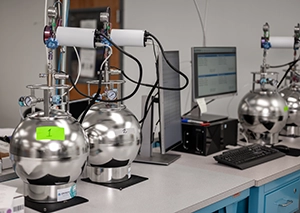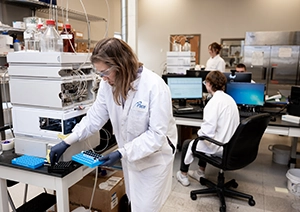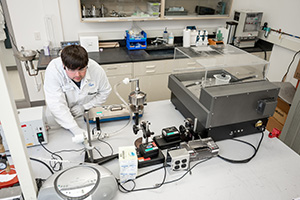People advancing science®
Partnering to provide the science, data and service you need to protect our environment and improve our health.
Analytical + Environmental
Analytical services, environmental testing and sampling designed to protect the places we work, play and live.
Pace® Minneapolis is now DoD-accredited for Non-Potable Water, Solid and Chemical Materials, and Biota under QSM 5.4 Table B-24 (1633). This expands our PFAS lab network to five locations, supporting federal and commercial sectors nationwide.
Introducing Keeping Pace® with Analytical Services
A new blog where environmental thought leaders share their views, opinions and insights.
We are People Advancing Science®. How Can We Support Your Project?
Working Together to Protect What Matters Most
Testing Matrices
Advanced, comprehensive, timely air quality testing services that meets your data objectives.
- Ambient Air
- Indoor Air Quality
- Meteorological Permit Monitoring
- Fenceline/Perimeter Monitoring
- Stack/Source Emissions
- Vapor Intrusion/Soil Gas
Accurate and reliable environmental testing services to analyze for contaminants and hazardous substances in soil, solids, and sediment.
- Bedrock Sampling
- Biosolids
- Petroleum
- Soil/Sediment
- Solid Waste
Pace® offers a wide range of water quality testing services and can help you protect one of our most precious resources.
- Drinking Water
- Ground Water
- Surface Water
- Wastewater/Stormwater
Pace® has been conducting biological tissue analysis for a wide range of contaminants for most types of plant or animal tissue for more than three decades. We have developed proprietary methodologies for tissue extraction and analysis to ensure accurate measurement of persistent contaminants in these matrices.
Pace® Environmental Microbiology Testing Services offer an extensive range of laboratory testing and analysis aimed at tackling environmental challenges related to microbiology. These services assist clients in diverse industries, such as healthcare, and pharmaceuticals.
Emergency Services
We are People Advancing Science®. When disaster strikes, Pace® Emergency Services are ready to help. From pipeline spills and plant explosions, to train derailments and Legionella outbreaks, we are able to quickly mobilize resources for sample collection and analysis.
Environmental Disaster
During any environmental disaster, timing is critical. After receiving your call, our emergency response team quickly coordinates with Pace® area locations to begin sample collection and testing immediately. We understand you need results fast to make important decisions to protect lives and to keep communities safe. Contact our environmental disaster team at 877.859.7778.
Legionella Outbreak
In the event you experience a Legionella outbreak at your facility, you need to mitigate the source of the outbreak quickly. Pace® Legionella consultants have deep experience supporting clients through outbreaks and health department investigations. We will provide guidance on Day 1 and coordinate inspections into possible infection sources so you can take immediate action. We can then develop a water management plan with you to continue keeping your facility safe. Should you experience an outbreak, call 412.281.5335.
Testing Services for Industries, Government and Healthcare
OUR PROMISE TO YOU
We honor our commitments so you can honor yours™. We
promise to deliver a level of quality that meets your data
quality objectives — supported by personal service, ethical
standards, data transparency, and the highest level of support
possible. People Advancing Science. This is the foundation of the Pace® Promise.
- RELIABLE DELIVERY
- COLLABORATIVE RELATIONSHIPS
- EXCEPTIONAL SERVICE
ESG COMMITMENT
As People Advancing Science®, we are proud to meet or exceed state and federal laws governing waste management and actively work to minimize our environmental footprint wherever possible.

Solvent usage and emissions
Waste and solvent disposal
Glass/container disposal
Shipping weight requirements
Education
Reporting
Audits
Optimization
Coolers
Recycling
Reducing
Solvent usage and emissions
Waste and solvent disposal
Glass/container disposal
Shipping weight requirements
- Online Education
- Lab Energy Audits
- Reusable Coolers
- Online Reporting
- Courier Optimization
- Solvent Recycling
THE RIGHT PARTNER FOR YOUR PROJECT
From routine testing to specialized analytical services Pace® has over 100 locations to support your project with both expertise and innovation gained from over 40 years.
600+
CERTIFICATIONS
& ACCREDITATIONS
NELAP
SDWA, CWA, RCRA, CAA
AIHA
Industrial Hygiene
USDA
ISO 17025
DOD/DOE
EPA
Conferences
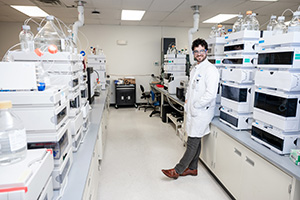
CETA 2024 Annual Conference
Industry leaders, experts, and professionals will converge to explore the latest advancements in our field.
Reno, NV | April 19-22, 2024
feature webinar
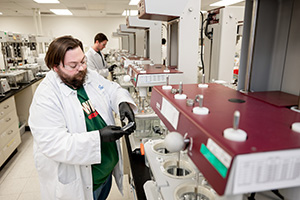
Quantifying PFAS in Consumer and Related Products: The Latest Developments
The concept of measuring PFAS in Consumer and Related Products has become one of the most talked-about subjects (aside from the suggested MCLs). Across the globe, PFAS bans and restrictions in “articles of commerce” have been in effect for many years and are constantly changing.


